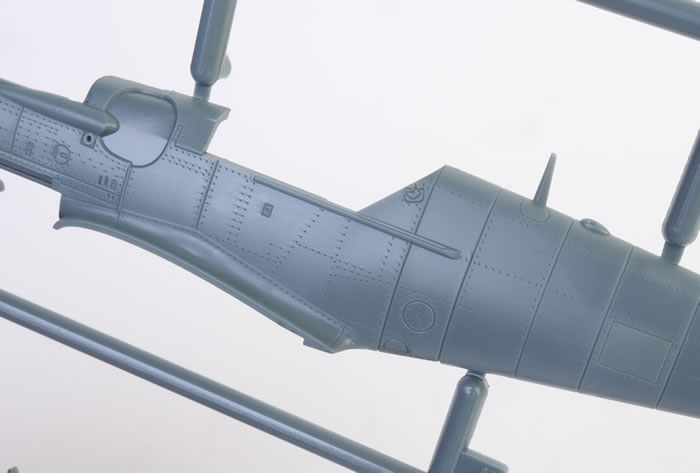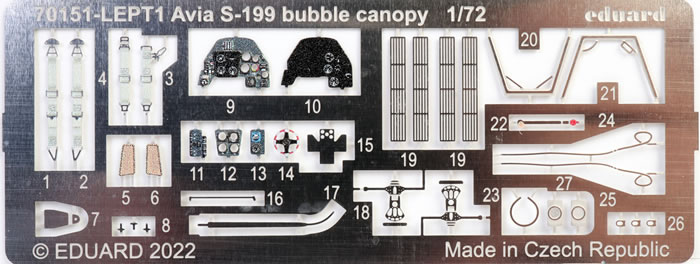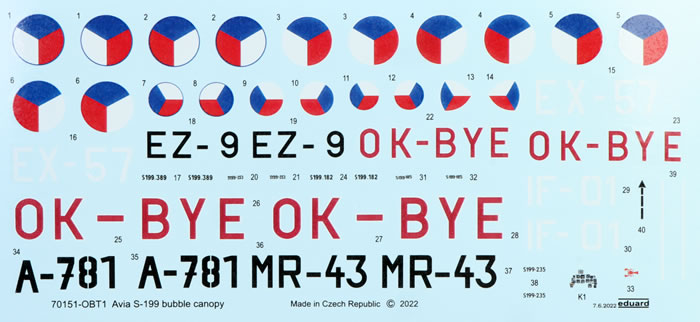Avia S-199 Bubble Canopy

Eduard ProfiPACK, 1/72 scale
| S u m m a r y : |
Catalogue Number: |
Eduard Kit No. 70151 - Avia S-199 Bubble Canopy ProfiPACK
|
Scale |
1/72 |
Contents and Media |
91 grey plastic parts: 10 parts in clear plastic: decals for six options; instructions.
|
Price |
USD$26.95 plus shipping available online from Eduard
GBP£14.50 EU Price (£12.08 Export Price) plus shipping available online from Hannants
and specialist hobby retailers worldwide |
Review Type |
First Look |
Advantages |
Well-moulded with several markings options, clear instructions, excellent decals, and a nice set of masks and PE parts to really add to the already great plastic parts.
|
Disadvantages |
None noted. |
Conclusion |
This is a splendid kit, well up to the best in the modern modelling world, and this appears to be capable of being made up into absolutely cracking little replicas by almost any standard of modeller and, in the hands of an expert, will be a really wonderful project. |
Reviewed by Graham Carter

This aeroplane has been available for a while through the KP kit of 2015, which was released as the early S-99 version and in both single, S-199, and two-seat, CS-199, forms in Czech and Israeli markings. It was a highly regarded kit at the time. Eduard’s Messerschmitt Bf109 E series of kits was launched in 2020 and met with much acclaim.

The real-life conversion in Czechoslovakia of surplus 109 Gs and Ks is an ideal excuse to do the same with parts of these moulds, but the differences have led to an entirely new set of moulds which bear no resemblance to the KP kit. Certainly most of the parts bear little in common with the ‘Emil’. This is the later bubble topped model, a modification introduced to afford the pilots a better view all round. The two-seat CS199 has already been released, as well as a Dual Combo kit.
The kit comes in the now standard giant strong box with a great image of one of the decal choices , EX-57 in a joint exercise with EX-58 of 3 Sqn, 18 Fighter Air Regiment in 1952.
The parts are beautifully moulded in the familiar mid-grey and the sprues are sealed in resealable clear sleeves with the clear sprue of canopies and sundry parts in their own sleeve for protection. The subtle surface and interior detailing is beautifully rendered, although there has been some criticism of the rivets along the vertical fuselage panels which apparently were sand smooth in reality - the modeller can do the same easily enough.

As is usual with these kits there are a number of unused parts destined for the spares box, in this case just seven can be saved for later projects. As a ProfiPACK Edition, you are treated to a wide selection of decal choices, six in all, a PE set, and masks for wheels and canopy. Speaking of which, I was delighted to see that Eduard have included a slightly wider sliding section for modellers who wish to pose it open. A narrower part is included for a closed canopy - a great idea I reckon, although there has been some criticism of the thickness of this sliding part - looks fine to my eyes.

The coloured photo-etched set contains a number of canopy details, some cockpit parts, a lovely 2-part instrument panel, seat belts, radiator matrices and some aerials. They are protected by a stout card backing. There is an option to fit the 20mm (?) cannon under the wings. The wheels are separate to the tyres to make painting easier, although masks are provided as well.

The A4 stapled instruction booklet begins with an outline of the development, and usage and the reason for the name Mezek or ‘mule’ in the Czech language. There are several places where I suppose the translator has struggled with English, such as the sentence “The aircraft had high tendency to run out off the course, which had to be negotiated by the pilot’ controls input” which I suppose is meant to say “ The aircraft had a tendency to wander off course, which the pilot had to negate through his control input”. There is also a section headed “Lacking Desperately” which I took to mean that the plane Desperately Lacked Performance, which it certainly did. Aside from those little niggles, the instructions are excellent, illustrating each step with coloured line-drawings and colour call-outs at each construction stage. Colours are indicated clearly at each step and are given in Mission Model, Gunze Aqueous and Mr. Color on a table below the parts map on page 2.
Markings
The six decal choices are illustrated with four-view drawings in colour and a nice variety there are. They include a stencil placement diagram, again in four views – very thorough.

As usual they are beautifully printed, glossy, thin and perfectly in register. A separate sheet contains a mass of stencilling for one aircraft. The six choices are, bar one, all in the enigmatic Czech ‘dark green’, which is simply referred to as ‘Green’ with number in the colour table.
There is plenty of discussion concerning the precise nature of this green if the modeller wishes to dive into the ether. All, bar one, have a full set of Czech tri-colour roundels.

They are as follows (and I am sorry that I could not teach my word processor to add all the marks above the letters in these Czech names) :-
-
S-199.389, EX-57 of Jaroslav Plecity, of 3 Sqn, 18 Fighter Air Regiment , Pilsen-Bory in 1952 with a red spinner,
-
S199.253, EZ-9 of Jilji Horak, Air Regiment # 5, Plizen-Bory (note the different spelling to the location above), February 1950 with areas of paint peeling on the fuselage,
-
S-199.182 OK-BYE of Jsef Sobota, Police Air Patrol, Prahu-Ruzyne, December 1949 in an attractive light grey over dark grey scheme with red nose, spinner, horizontal tail and leading edges to the wings, and large OK-BYE registrations across both wings in red on white,
-
S-199.183 IF-01 of #1 Air Training Regiment, Olomouc in 1953, again with red spinner,
-
S-199.334 , A-787 of Milan Pohlodek, Air Military Academy, Hradec Kralove, March 1950 with a blue and white spinner, and
-
S-199.235, MR-43 of Jan Sure, 2 Sqdn, 8 Fighter Air Regiment, Klecany, May 1951 with a white spinner.
It is great to see this ‘different’ variant of the later Bf109 series available in such a beautiful kit, and it certainly comes recommended to all modellers with an interest in this aircraft type and era. I’m pretty sure we will see an Israeli version of this kit soon enough.
Thanks to Eduard for the sample

Review Text & Images Copyright © 2022 by Graham Carter
Images Copyright © 2022 by Brett Green
Page Created 15 August, 2022
Last updated
15 August, 2022
Back to HyperScale Main Page
Back to Reviews Page |
